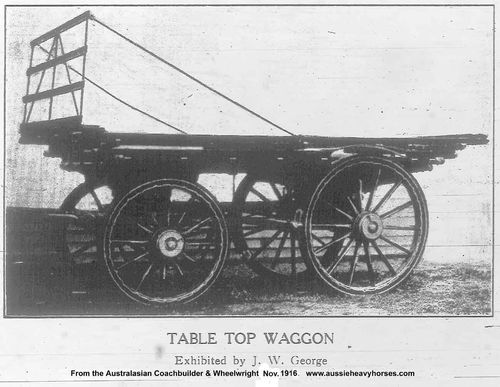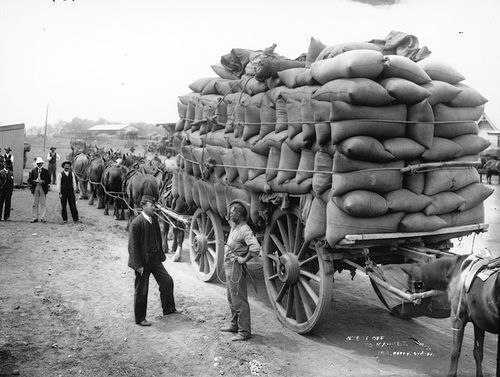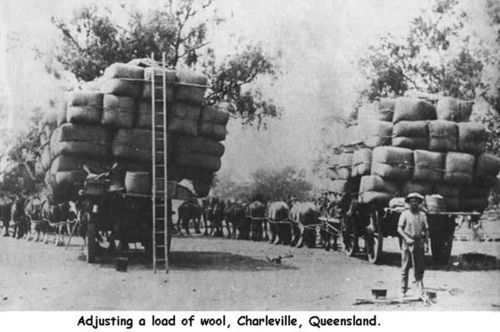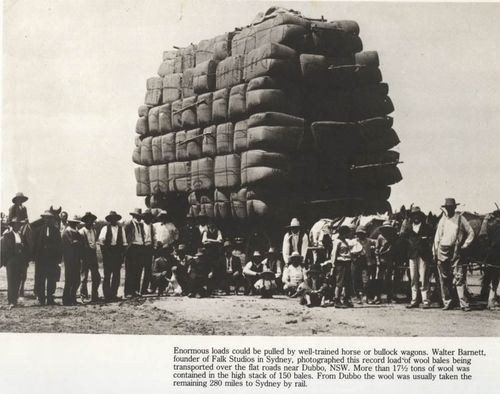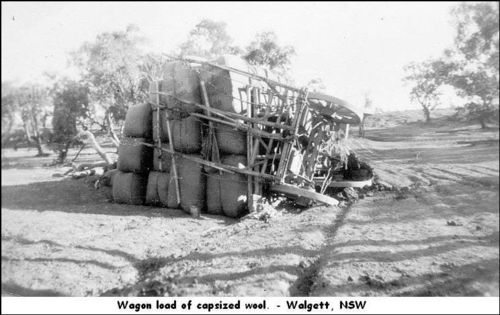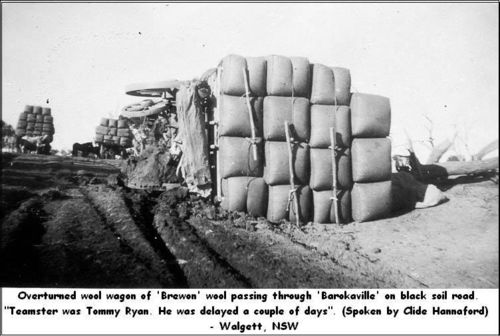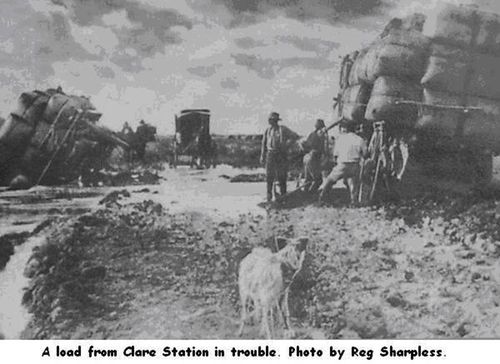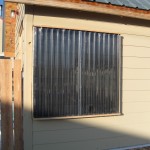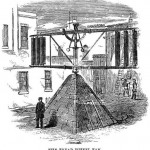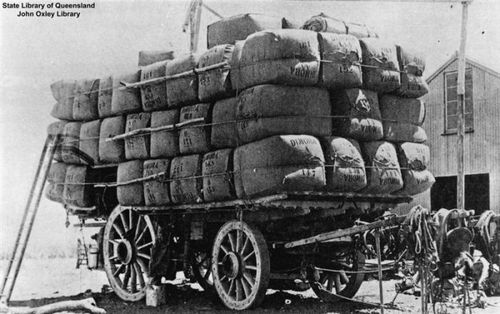 The Table Top Wool Wagon is among the largest animal-drawn road vehicles ever built. It was a unique Australian invention, built to transport wool from sheep farms to train stations and harbours.
The Table Top Wool Wagon is among the largest animal-drawn road vehicles ever built. It was a unique Australian invention, built to transport wool from sheep farms to train stations and harbours.
As many as forty bullocks, or thirty horses, pulled the vehicles over distances of up to 1600 km.
Table Top Wool Wagons (also known as “jinkers” or “ships of the desert”) appeared at the end of the nineteenth century and remained in use until the 1920s, when they were replaced by trucks.
The Vehicle
The Table Top Wool Wagon evolved from a somewhat smaller vehicle that appeared in the 1870s and carried a load of between 5 and 6 tonnes of both wool and wheat. The larger versions, especially designed for wool, appeared in the 1890s when road conditions improved. They reached their zenith in the 1910s. Below is a picture of a medium sized wagon (5 m long, 2 m wide) with a removable hay frame.
The Table Top Wool Wagon was up to 8.5 m long and 2.5 m wide, and its wheels were up to 2.5 m in diameter and 20 cm wide. The wagon had no sides, hence its name, but the platform curved upwards by 5 cm at the front and rear. This caused the bales of wool to lean towards the middle and steady the load. The vehicles had a loading capacity of 10 to 15 tonnes, with record loads of over 17 tonnes.
The Engine
Such heavy loads required large teams of draught animals, especially on muddy roads. Four horses were needed just to move the vehicle around when it was empty. When fully loaded, up to forty bullocks or thirty horses could be yoked to the front, and donkeys and camels were also used. Drivers did not sit on their wagon loads, but led the way on horseback or by walking, and the vehicle was steered by the lead-horses.
Road and weather conditions usually determined whether horse teams or bullock teams were used. When roads were either very rough, or did not exist at all, bullocks were of much greater use than horses.
The driver was often accompanied by his wife and family who rode in a horse-drawn wagonette that the women drove. A cattle dog completed the gang.
The Routes
Many wagons were driven from Ilfacombre to Rockhampton, a journey of almost 800 km. The trip took three months — longer when it rained, and only half as long to return with empty carts. Ilfacombre had the largest wool scouring plant in Queensland, with most of the wool from that area being washed there.
Washed wool was a lot lighter, so you could put a lot more washed and dried wool into a bale and ship it more cheaply. Other destinations of the Table Top Wool Wagons were Adelaide, Sydney, Melbourne, Brisbane, and Perth, with travel distances of up to 1600 km.
The Challenges
There are records of wagons taking two years to complete a journey to the coastal markets. All too often, a wagon would tip over, particularly after rain. The only remedy was to unload, upright the wagon, and wait for the road to dry.
Hills presented another challenge. The most common form of slowing the descent involved chaining a felled log
to the back of the wagon. To cope with steep hills, some wagons had their wheels ‘spragged’ — that is, they thrust a sapling between the spokes of each pair of wheels so that it jammed against the wagon floor.
Table Top Wool Wagons disappeared in the 1920s, when they were replaced by trucks and the gradually extending railways.
Kris De Decker. Edited by Deva Lee.
Sources and more information:
- “Progression of a table top wool waggon“, Scale model horse drawn vehicle forum.
- “Technology in Australia 1788 – 1988“, Compiled by Fellows of the Australian Academy of Technological Sciences and Engineering, 1988
- “Wheat wagon at Narromine railway station, NSW“, the Powerhouse Museum.
- “Wool wagons bogged on the Mossgiel-Ivanhoe road“, NSW
- “The Boer in war and peace“, Arthur M. Mann, 1900
- “The teams of the Blacksoil Plains”, Douglas Harris, 1977
- “Wool, wagons and clipper ships: transport, trade and travel in Australia 1830s to 1880s“, Allen & Unwin, 2008
- “The horse and buggy days“, H. McGregor, 1981
- “Outback in Australia”, W.K. Harris, 1913
- “Early Road Transport“, Kenton T. Cameron, 1953
- “Bennet’s patent table-top wool waggon“, The Sydney Mail, April 25, 1906
- “Romance of Australia’s 1926-27 wool clip“, The Mail, 14 august 1926
- “Wool drays and the curious case of the missing bodies“, the Powerhouse Museum. (A bizarre example of early Photoshopping).
- “Progression of a model“, Scale model horse drawn vehicle forum
